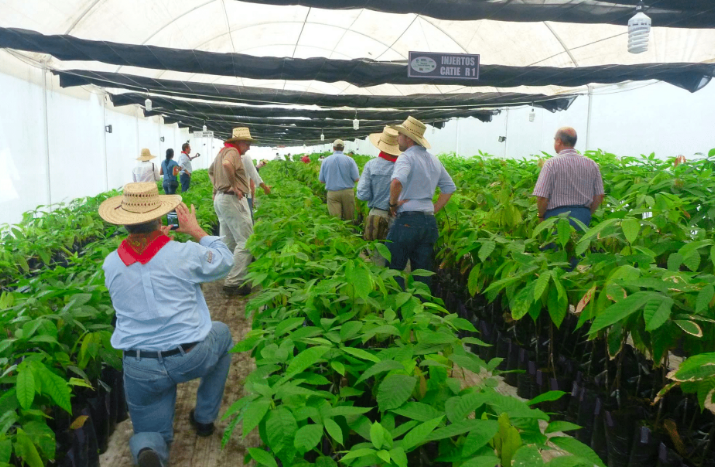The Status of Research in the Field

Seeking High Temperature and Drought Tolerance in Cacao. A Knowledge Sharing Platform
An integrated approach to improving yield efficiency and resilience in the face of climate change through better use of cacao genetic resources.
Côte d'Ivoire: CNRA (Centre national de recherches agronomiques)
Côte d'Ivoire: CNRA (Centre national de recherches agronomiques)
With a record production of 2.010 Million tons of marketable cocoa beans produced in 2016-2017 (ICCO, 2017), Ivory Coast cocoa farming covers an area of more than 2 176 000 hectares ( 6% of the national territory) and with more than one million farmers. In addition, cocoa generates more than 30% of export earnings and accounts for more than 15% of Ivorian GDP.
The challenges
In Côte d’Ivoire, four main constraints render Ivorian cacao plantings extremely vulnerable to climate change:
- ageing trees, where 19% of cacao plantings are older than 30 years;
- low levels of improved material, where 70% cacao plantings are ‘unimproved’ farmers’ selections;
- high pest pressure from mirids (30-40 %), Black Pod (20-45 %), and Cocoa Swollen Shoot Virus,
- increasingly longer periods of drought (3 to 4 consecutive months of drought in some cocoa producing regions).
All of these factors will constrain performance under drought. Apart from tree or leaf death (figure 1), drought causes pod and seed desiccation and rotting, and seeds sticking to the pod linings, thereby reducing productivity and quality (figures 2 and 3).
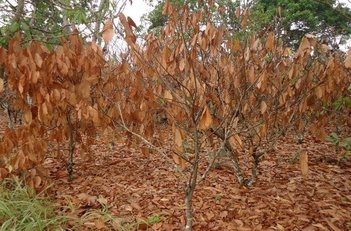 |
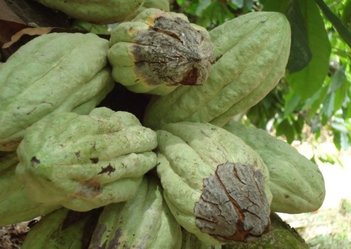
|
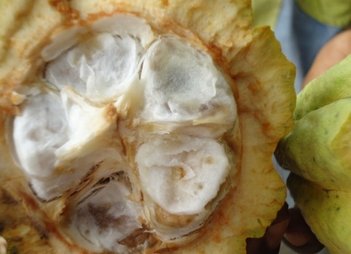 |
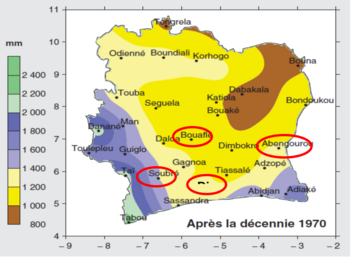
|
Study sites
Four contrasting agro-climatic zones were selected for establishing test plots to collect primary data: Abengourou, Bouaflé, Divo and Soubré (see figure 4).
- Abengourou area, located in eastern Côte d'Ivoire. Between 2004 and 2016 this zone was subject to an interannual evolution of rainfall marked by three (3) periods: two water deficit periods (2004 to 2006, and 2013 to 2016) characterized by negative pluviometric indices, between which, intervenes a surplus period (2007 to 2012) marked by positive rainfall indices. The linear trend curve with a positive slope of almost zero (0.0008) shows a slight upward trend of rainfall over the period 2004-2016.
- Bouaflé area, located in central-western Côte d'Ivoire. In contrast to Abengourou, Bouaflé has been subject to an interannual change in rainfall marked by four (4) periods between 2004 and 2012: two periods of surplus (one in 2004 and the other from 2007 to 2012) characterized by positive indices and two deficit periods lasting two years each (2005 to 2006 and 2011 to 2012) characterized by positive indices. The linear trend line has a steep and negative slope (-0.0952) which indicates a downward trend of precipitation towards increased drought over the period 2004 to 2012.
- Divo area, located in central-southern Côte d’Ivoire. The year-to-year change from 2004 to 2017 was marked by three periods: two surplus periods (2004 to 2007 and 2012 to 2017) separated by a deficit period (2008 to 2011). The negative slope (-0.011) of the linear trend line reveals a general downward trend in rainfall over the period 2004 to 2017.
- Soubré area, located in south-western Côte d'Ivoire. Between 2004 and 2017, Soubré's seasonal rainfall series was marked by 4 periods including two surpluses (2004 to 2006 and 2010 to 2013) and two deficit periods (2007 to 2009 and 2014 to 2017). The negative and steep slope (- 0.039) reflects a general downward trend over the entire period 2004-2017.
Material evaluated
The cacao genotypes available for this study include a total of thirty-eight (38) CNRA hybrid families of which 15 (F1 to F15) were planted in the areas of Abengourou, Bouaflé, Divo and Soubré at the same time as 15 local farmer-selected cultivars, selected for their agronomic and quality performance.
Measured Traits
Measurements and counts carried out tree by tree focused on the parameters below:
Production and technological quality parameters per tree:
- Number of healthy, gnawed and rotten pods
- Number of wilted chérelles and total chérelles (to calculate the rate of wilted chérelles)
- Pod weight
- Number of beans per pod (normal beans and flat beans)
- Weight of 100 ‘commercial’ cocoa beans
- Weight of 1 commercial cocoa bean.
Vigour parameters measured per tree:
- Collar diameter 30 cm above the ground
- Circumference of tree trunks 130 cm above the ground
- Height of the tree
Morphological and physiological parameters:
- Length and width of leaves to calculate leaf area (on 3 adult leaves / tree)
- Foliage density (on a scale of 1 to 4)
- Foliar density (on a scale of 1 to 4)
- Flush Intensity (on a rating scale of 1 to 4)
- Sensitivity to leaf loss following a long drought (range 0-5).
Soil parameters:
- Relative humidity of the soil at 20 cm depth
Climate parameters:
- Daily rainfall data at different times
- Pluviometry with direct reading on the different sites.
Results
With the exception of field resistance to brown rot of hybrid family pods (assessed by the rate of rotten pods) a highly significant zone-family interactions (probability <0.0001) were identified for all other characters measured.
This suggests that for the characters involved, the agroecological zone impacts the behaviour of the families. In particular, the study demonstrated the negative impact of drought on bean production evaluated by the weight of 100 cocoa beans. Bean production was significantly lower in Abengourou (more intense drought) compared to Divo (low rainfall area). It is interesting to note, however, that for the majority of the parameters studied, six hybrid families were ranked among the top ten families in all study areas, thus highlighting the stability of these families for these traits regardless the study area.
The study also demonstrated the feasibility of selection using:
- three (3) criteria (vigour, leaf density and canopy density) that are potentially innovative for evaluating the resilience of cocoa trees to drought;
- four (4) farmer-selected families remarkable for their low rate of brown rot (4-9%) in Abengourou, a region where P. megakarya is the most damaging species in the field;
- nine (9) farmer-selected families remarkable for their average weight of 100 high cocoa beans (140.3 to 168.3 g), especially in Abengourou where the drought had a negative impact on the size of cocoa beans.
This study highlights the importance of evaluating farmer-selected material for a standard range of physiological traits in a follow-on phase. For the first phase of the 12-month project, the achievements presented are just as important as they are encouraging. Additional observations are nevertheless necessary to confirm the results thus obtained.
For further information, the focal point is Dr. Tahi Gnion Mathias, Researcher, Cocoa Geneticist, Cocoa Program Manager at CNRA.
Colombia: Agrosavia
The Colombian Agricultural Research Corporation, Agrosavia, aims to work in the generation of scientific knowledge and agricultural technological development, through scientific research and technology generation. Agrosavia seeks to improve competitiveness of the rural sector, equity in the distribution of the benefits of technology, sustainability in the use of natural resources and strengthening of scientific capacity, that allows to contribute to raising the quality of life of the population.
Agrosavia has 13 research centres throughout the country, of which, 11 centres participate in the cocoa research agenda. In 2018, Colombia reached a cocoa production of 56,867 tons and, 176.050 hectares planted. The most productive cocoa departments are in the following descending order: Santander, Antioquia, Arauca, Huila, Tolima y Nariño. Santander is recognized as the largest producer of cocoa in the country having a contribution of 41% of the national cocoa production. Colombia has an important internal demand for cocoa and its products especially as drinking chocolate. The Colombian government has promoted the growth of the sector in the context of post-conflict development.
Study sites and methodology
In the departments of Santander and Antioquia, two experimental trials have been established to evaluate the performance of 19 cocoa clones by different traits like productivity and disease resistance. Clones in evaluation were obtained by mass selection in local plantations between 1996 and 1999. The field trials were established in 2014 in a lattice design with three replicates and 20 plants per experimental unit under an agroforestry system. Experimental trial in Santander department has been established in La Suiza Research Centre at an altitude of 550 m.a.s.l, average temperature of 28°C and relative humidity of 85%. Field trial in Antioquia department is located in El Nus Resarch Centre at an altitude of 860 m.a.s.l, average temperature of 24°C and relative humidity of 83%.
Results
Data analysis of variance showed significant differences for the clone and location interaction of the number of healthy pods and M. roreri incidence on cacao clones across three environments, indicating the possibility of selection for stable genotypes. Incidence of Phytophthora spp. in cacao clones was affected by genetic factors and location but there was no significant effect of the interactions between clones and locations for the incidence of this pathogen.
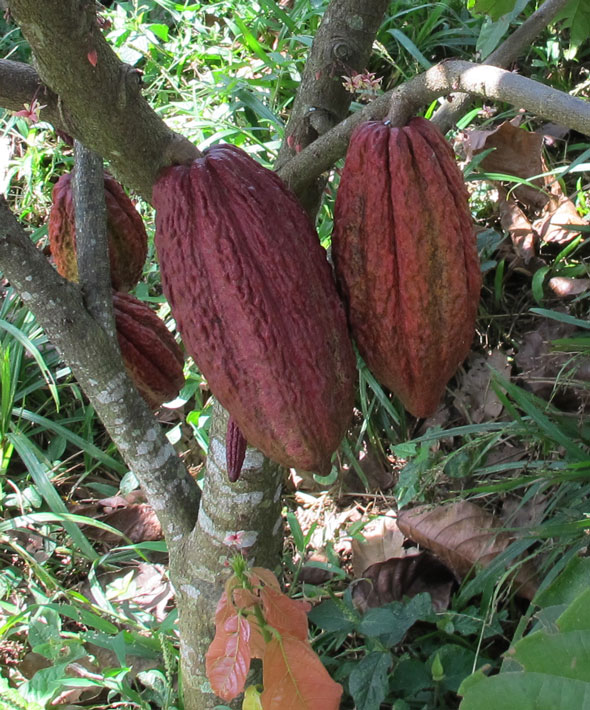
Costa Rica: CATIE (Centro Agronómico Tropical de Investigación y Enseñanza)
CATIE houses 1200 genotypes as one of only two international collections. Initiated in 1996, its Cacao Breeding Program has identified sources of disease-resistance and developed high-yielding, disease-resistant and high-quality varieties, especially genotypes with resistance to moniliasis. Their breeding programme often includes two evaluation cycles, which means from first crosses to distribution of improved material to farmers can take up to 15 years. Evaluations include for productivity and disease resistance, pod and seed indices, compatibility and morphological characterization. The programme has distributed improved material benefitting thousands of Costa Rican families, built farmer and scientific capacity (especially grafting techniques), and contributed to quality improvements (fermentation protocols and quality lab).
Study sites
CATIE has provided extensive datasets from their two contrasting sites in Turrialba and La Lola, that are being analysed by the CFCE-CC project for genotype x environment (G x E) interactions (physiology).
Methodology
Boosted Regression Trees: to investigate the ecological dependence of a species on the environment and to determine 'habitat preference' in order to extrapolate patchy biological data to a larger domain.
Results
CATIE has so far provided extensive datasets from one of its sites -La Lola-. Local climate greatly differs from other country sites, with excess water, flooding and high disease pressure, so CATIE’s dataset provides an opportunity for a novel analysis of climate data and disease incidence, as well as yield dynamics.
Yield dynamics: The data analysis provided insights on yield dynamics and climate over time. Analysis of 18 years’ production data shows that yield increased in the first 14 years, then decreased. Data analysis demonstrates that ante-dependence modelling can assist breeders in more effectively selecting material expressing physiologically-based climate-resilience, for integration into breeding programmes for cacao climate-resilience.
Modelling work on influence of environment on pollination and bean yield by Ribeyre et al., (2017) also merits further comparison, when considering physiological traits for breeding. In their work, they aim to explain the distribution of the number of beans per pod for a given clone.
Disease: The analysis determined which variables predicted the presence on a tree of moniliasis and phytophthora and the number of pods produced on diseased trees, using an unsupervised machine-learning method, boosted regression trees. Analyses provide some corroborations with findings from other studies on interactions for phytophthora and moniliasis as follows:
Phytophthora: The presence of black pod rot can be predicted mainly from the sensitivity of the clone to phytophthora, and to a lesser extent, the number of pods on the tree, the status of the tree (phytophthora or not) in the previous year, the average temperature in December and the average annual temperature. Analysis shows the most sensitive clones having a much higher risk when they have more fruit and simultaneously when the temperature exceeds 25C.
The number of pods affected by decay on a diseased tree can be predicted from the same variables, but the susceptibility of the clone seems to have no influence, while overall rainfall plays a more important role.
Moniliasis: It is the number of pods that is the most predictive of the presence of moniliasis and to a lesser extent, the disease susceptibility of the clone and the average temperature. The previous status (moniliasis or not) has little influence. The number of pods affected by moniliasis on a diseased tree is mainly related to the number of pods on the tree. The sensitivity of the clone has no influence.
Ascending hierarchical classification identified three clones of special interest (CATIE-R1, CATIE-R4, CATIE-R6), which are not high-yielding but which are relatively resistant to moniliasis and moderately susceptible to phytophthora. A second interesting group is more affected by diseases (ARF-4, CC-137, EET-183, ICS-43, ICS-95 T1, PMCT-58)
A slight increase in the average annual temperature would therefore lead to a slight increase in the number of diseased trees, while only the quantity of rotten pods on diseased trees would increase, particularly in unproductive trees. On the other hand, a slight increase in rainfall will increase the number of rotten pods.
Brazil: UESC (Universidade Estadual de Santa Cruz)
UESC’s cacao programme focuses on evaluating promising (ortho- and plagio-tropic) clones and rootstocks for improved productivity, and for drought and disease resistance, and on developing improved renovation and propagation methods. Interesting trials results indicate promising drought tolerance in five clonal crosses, and have identified nine growth variables implicated in drought tolerance. UESC also works closely with Mondelez. They have recently completed two cacao collecting missions in drier Brazilian regions, and it is anticipated that most of the 57 accessions collected will possess some level of drought tolerance.
Within the CFCE project follow-on phase, they are hoping to establish a greenhouse nursery of these accessions.
Case Study: Effect of drought on cocoa plant mortality and bean production at Oceania farm in Itagiba, Bahia
In recent years, Bahia has lost 25% of its cacao trees to drought and fire (in the 2015/2016 drought ~ 53 million trees died). Since 1980 average regional annual rainfall has halved from around 1750mm to 800mm, in its humid, sub-humid and dry regions, and many cacao plantations have become pastures. UESC is exploring the variation in productivity due to drought on Oceania farm, Itagiba Bahia and deepening knowledge of the effects of drought associated with soil physical characteristics.
Oceania farm has collected extensive production, mortality and climate data since 1986. It selected 36 plots to study productivity, soil and nutrient status. More than 45% of the farm’s trees died since the 1980s, but tree mortality was uneven across the farm and between plots. Farm soil chemical attributes have varied widely over decades, but physical, mineralogical and physiographic attributes soils have remained quite stable. WCF's support for drought study in cocoa is being used to analyze the 33-year dataset, regarding plant mortality, production and rainfall data. These data are being analyzed and correlated with soil and physiographic variables to identify factors associated with drought that influence mortality in cocoa trees and production over time.
The study will link with another study of 100 cacao potentially drought tolerant genotypes in greenhouse and field trials to develop drought tolerant rootstocks, partly financed by Mondelez International.
